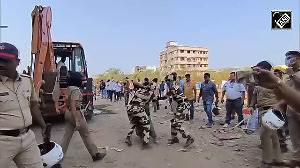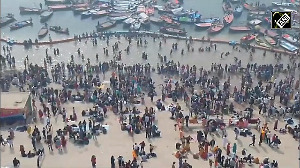With the water level in the Yamuna showing a rising trend, the Delhi government urged people on Monday to stay put in the relief camps while assuring them that they are not facing any threat, even as some of them returned to their homes and shops to begin the exercise of rebuilding them.

Authorities meanwhile continued the work of pumping out water from flooded roads, with officials saying the water has been cleared from almost all the roads, barring a carriageway of the ITO stretch and Rajghat. However, the removal of silt and mud is being done.
Delhi is in the middle of battling one of its worst flood-like scenarios due to the recent heavy rain, with more than 25,000 people evacuated from inundated areas.
According to official data, approximately 26,784 people have been evacuated from the flood-affected low-lying areas of Delhi, out of whom around 18,416 people are staying in 47 relief camps (including temporary camps as well as pucca buildings -- schools, community centres etc.).
The others have been shifted to the places of their choice -- relatives' houses, rented accommodation etc.
Traffic movement has resumed on Ring Road, the Delhi Traffic Police said while cautioning people to take proper care while driving on the roads and plan their journey accordingly in view of the slippery and muddy conditions.
The traffic movement has resumed on Ring Road in both the carriageways between the Wazirabad flyover via Majnu ka Tila to the ISBT-Kashmere Gate for medium and light vehicles, it said.
According to Public Works Department (PWD) officials, one carriageway was opened on Vikas Marg, between Laxmi Nagar and ITO, while work is underway on the other carriageway and at Rajghat.
The water level of the Yamuna reached 206 metres at 10 pm on Monday and remained above the danger mark of 205.33 metres, according to the Central Water Commission (CWC). The water level was at 205.52 metres on Sunday night.
As the water level in the river is showing a rising trend again after showing signs of calming down, Delhi minister Atishi urged people to stay in the relief camps.
Due to heavy rain in some areas of Haryana on Sunday, the water level of the Yamuna rose slightly, she said.
'The Central Water Commission estimates that it can reach 206.1 metres overnight. But there is no danger for the people of Delhi from this.
'But all the people staying in the relief camps are requested not to go back to their homes just yet. Go back to your homes only after the water level goes below the danger mark,' Atishi said in a tweet in Hindi.
The water level of the Yamuna, which breached the previous record of 207.49 metres last week and crossed the 208-metre mark on July 12, is still flowing above the danger mark of 205.33 metres.
The Monastery market, one of the worst-hit places due to the flooding, showed signs of returning to normalcy as shopkeepers came back to clean their shops and assess the damage.
The Municipal Corporation of Delhi (MCD) was also directed to carry out fumigation of the flood-affected areas to avoid the spread of diseases when people return.
Children who lost their school uniforms and books in the flood will be allowed to attend classes without those until new sets of uniforms and textbooks are arranged for them.
While ministers Gopal Rai, Imran Hussain and Raaj Kumar Anand visited the relief camps to take stock of the facilities there, Health Minister Saurabh Bharadwaj visited the Swami Dayanand Hospital in Shahdara and Lal Bahadur Shastri Hospital in Khichripur to gather details on their preparedness to deal with cases of dengue and malaria.
Cases of conjunctivitis and skin allergy are being reported from the relief camps, Bharadwaj told reporters during his visit.
In a statement, he said disaster management wards have been set up in hospitals for patients afflicted with vector-borne diseases.
"Cases of conjunctivitis, skin allergy, fever are being reported from most of the relief camps. Currently, no case of vector-borne diseases has been seen in the camps. Patients in the relief camps showing symptoms of any disease will be admitted and monitored in the disaster management wards of hospitals. It will also be known whether any new epidemic is spreading in the relief camps," he said.
Bharadwaj added that even after the flood-hit people return to their homes, the government will continue to monitor the situation and strict action will be taken if any disease trend is seen anywhere.
Chief Minister Arvind Kejriwal said the Wazirabad water treatment plant, which was shut down amid the flood-like situation in Delhi, has started producing 54 MGD (million gallons per day) of water and will soon be operating at full capacity.
The plant has the capacity of producing 134 MGD of treated water.
In a tweet, Kejriwal said the equipment at the plant suffered the 'most damage' due to the flood-like situation.
Three water treatment plants -- Wazirabad, Chandrawal and Okhla -- were shut down on Thursday due to the rising level of the Yamuna.
The Okhla plant was opened on Friday.











 © 2025
© 2025